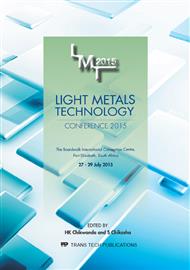p.441
p.447
p.453
p.461
p.468
p.474
p.485
p.492
p.499
Investigations on Fire-Resistant Magnesium Alloys for Aerospace Applications
Abstract:
Light metals are contributing significantly to the weight saving of components and structures of transport means. Regarding airliners FAA recently published a report on the development of a flammability test for magnesium alloys to be used in aircraft seat construction which opens up the options to introduce specific parts in next seat models. In former projects, it was shown that magnesium alloys are offering interesting mass reduction and-by this-fuel & emissions saving potentials in air transport. The major concern is the behaviour of Mg alloys in case of an aircraft fire which was investigated by FAA for particular alloys of Magnesium-Neodymium-Gadolinium, Magnesium-Yttrium-Rare Earth as well as Magnesium-Aluminium-Zinc composition in course to the test methods development. While clearly the AZ31 alloy fails in such a laboratory test, the other two types pass flawlessly by exhibiting a self-extinguishing behaviour shortly after removing the fire source. None of them are specifically usable for high pressure die casting or thixomolding processes which both are common production methods. From the typically used thixomolding alloys like AZ91D, AM50A, AM60B or AJ62A, the Magnesium-Aluminium-Zinc again is likely to fail in flammability tests due to the low-temperature melting network of eutectic phase. Therefore, the development focussed on Magnesium-Aluminium-Manganese and Magnesium-Aluminium-Strontium type alloys. Calcium – well known for the ability to improve the flammability behaviour – was added in certain concentrations to those alloying systems and investigated regarding self-extinguishing performance, manufacturing issues as well as mechanical properties. The results of these examinations are presented in the following paper.
Info:
Periodical:
Pages:
492-498
Citation:
Online since:
August 2015
Authors:
Keywords:
Price:
Сopyright:
© 2015 Trans Tech Publications Ltd. All Rights Reserved
Share:
Citation:


